


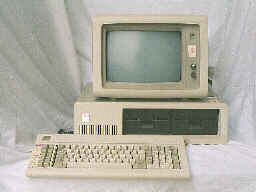
The Original IBM PC
Inventory No: 0112
The original IBM PC first appeared on the market in 1981. The two floppy disk drives in the model illustrated were optional extras. The standard machine had a cassette tape interface for data storage. Internally, the machine has five 8-bit ISA (Industry Standard Architecture) bus slots.
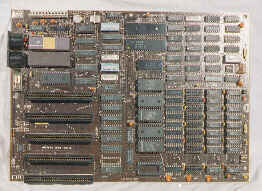
IBM PC 5150 Circuit Board
An original IBM PC motherboard. At the upper left, there are two black connectors; the upper one is for the keyboard and the lower one is to connect to an audio cassette. Below this is a relay to control the cassette drive motor.
Immediately to the right of the connectors are the 8087 coprocessor (an optional extra) and the Intel 8088 CPU. The memory is the block of chips to the lower right of the board, 8 bits and one parity bit (one bank has been removed). Lower left of the board are the five 8-bit ISA slots.
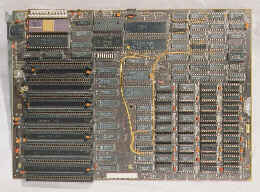
IBM PC XT 5160 Circuit Board
The PC XT had the same 8088 processor as the PC, the major difference being the presence of eight 8-bit ISA slots and the absence of the cassette connection and relay. Floppy disks were now a standard fitting. This board is also fitted with the 8087 maths coprocessor (top left), which was still an optional extra.
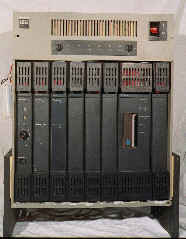
IBM 7552 Industrial Computer - Model 140
Inventory No: 0180
The IBM Industrial Computer 7552 is a ruggedised PC, designed for for use in an industrial plant environment. The 7552 was based on the Intel 80286 processor, running at 10MHz and had 512KB of system memory as standard (expandable to 3MB).
The model was announced in July 1987 and initially, two variants were available, the 040 and the 140. The model 040 lacked any form of disk storage, while the 140 was fitted with a disk adaptor which was designed to accommodate a 3½ inch 720KB diskette drive and one or two 10MB hard disk drives (one drive was the usual option and the disk itself was an extra).
This machine is interesting because unlike the PC series, this is a bus-based machine. The bus is a little quirky as it combines the MicroChannel bus of the PS/2 series machines with a subset of the ISA peripheral bus and then adds a few 7552 signals in for good measure. The backplane has space for 9 modules (card shrouds). As the disk-drive module is double width, the model 140 can accommodate a total of 8 modules. A module can be plugged into any position in the bus but the standard arrangement was, from left to right; System Resource Card, Processor Card, 5 accessory cards or blank modules, double width Disk Assembly.
The model illustrated does not exactly conform to this standard. The arrangement is (L to R) System Resource Card, Processor Card, Additional memory, ISA Video Card, empty shroud, empty shroud, Disk Assembly (with two 10MB disks!), empty shroud.
The 7552 machine was designed to be able to function without keyboard or screen and was capable of being controlled remotely. Remote control required an optional module, the Remote Terminal Interface (RTI). The 7552 was also capable of being run from a 24 Volt DC supply but it had to be started using AC mains (or an inverter).
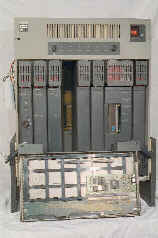
Module opened showing ISA adaptor
The 7552 with a module (card shroud) removed and opened to show the ISA adaptor fitted with an ISA video card. This facility to use ISA cards in the industrial computer was unfortunately discontinued later in the series. Each card shroud held a single card and the shroud provided a firm means of location and also ensured adequate air flow and cooling in unfavourable operating environments.
A 7552 board would normally fill the card shroud and make connection with the bus through two connectors. (Bottom left and bottom centre of the card shroud in the illustration).
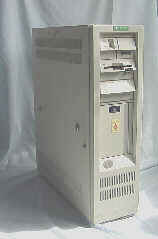
IBM Personal System/2 Model 80
Inventory No: 0150
The PS/2 was IBM's attempt to regain control of the microcomputer market.
Because of the way that the PC had been marketed, as an open system, it was possible for other manufacturers to produce clone machines, to IBM's detriment. The PS/2 series of machines were produced with a closed architecture (Micro Channel Architecture - MCA); IBM retained the details of this, in the hope of regaining market share with a superior machine.
Unfortunately, while the PS/2 machines were better and faster than contemporary versions of the PC, they were much more expensive and their performance advantage was soon lost as improved versions of the PC were introduced.
They are interesting because they illustrate one of the (many) blind alleys in the development of computer technology (and they are very well engineered).
The illustration shows a model 80 machine, this has an Intel 80386 CPU and a 115MB EDSI disk.
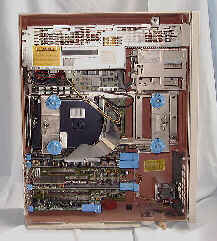
IBM PS/2 - side panel removed.
The inside of the model 80. The power supply at the top takes up the entire width of the machine. Below this on the extreme right is fitted a single 1.44 MB floppy disk drive. In the centre of the machine are four blue knobs. These fix the disk drives. On the left is a full height 5¼ inch EDSI 115 MB drive, the second disk is not present. Below the disk bays are the MCA cards with their blue plastic handles. There are 8 slots, the top one holds a disk controller. The others are network cards and additional memory.
A typical MCA card is shown here: Microchannel Architecture Card (47251 bytes)